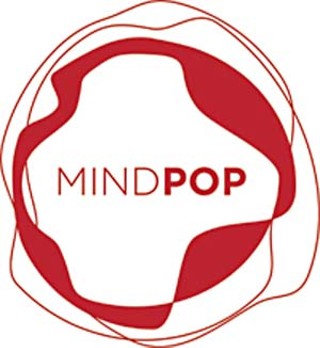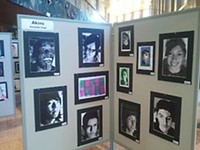Learning Desire
MindPop thinks about arts education in whole new ways, and what a difference it makes
By Robert Faires, Fri., Oct. 12, 2012

Say you're near a child who's struggling – maybe a kid flailing in a pool or stumbling in the dark – and you're not only in a position to help, you have the means to do so right in your hand: a flotation ring you can give him or her, a flashlight you can turn on. Why would you not want to aid that kid?
That's a question Dr. Brent Hasty is working hard to address. This Austin educator knows that our schools are full of children and youth who struggle and consequently don't want to be there. And he knows that students who become involved in the arts stay in school longer and are more likely to go to college, be employed in a job with a future, and volunteer in the community. So since the arts are already in schools – in traditional music, drama, and visual arts classes, yes, but also in programs run by area arts organizations in partnership with schools and in the lucky classrooms where arts activities are integrated into the study of core curriculum subjects like social studies and science – it seems like the proverbial no-brainer to throw those struggling students a lifeline by amping up the presence of and access to the arts in school.
Dear reader, I can sense you, after hitting that last period, now steeling yourself for yet another stale screed bewailing the decline in arts education in this country and how the philistines wielding the budget axes have hacked away at our cultural heritage blah blah blah. But before you hastily flip the page or click your way to the comical refuge of "News of the Weird," be advised that this is not one of those stories. This is one of those they-said-it-couldn't-be-done stories, a how'd-they-pull-that-off story, a this-could-change-everything story.
See, Hasty and the organization that he directs have managed, in just three years, to talk to all the arts education stakeholders in town – we're talkin' the Austin Independent School District; city government; dozens of arts organizations that provide arts-ed services; the business, philanthropy, and higher education communities; and parents – bring them together in a summit on the current state of our arts education system, then have them spend a year identifying the gaps in it and developing a plan to fill them; build an online directory of all the creative learning programs in the area, searchable by artistic discipline, grade level, provider, and cultural origin; get Austin involved in a notable national initiative for expanding arts education efforts; and secure a $1 million gift that established a fund for AISD teachers to enhance their course work with creative learning projects.

Considering the inability of previous efforts of this kind to gain traction – Hasty was involved in an attempt to align schools and the arts community in 2000 and 2001 that, he says, "bubbled up and then died" – and the glacial pace at which ambitious creative enterprises in Austin historically move, to achieve just one of those goals in three years would be remarkable. Accomplishing all four in that span is unheard of. Something is different here.
Indeed, everything is different here. The name of Hasty's organization, for starters: MindPop. For once, an arts education outfit name doesn't have the fusty air of an old-school old school or is just four words clumsily conjoined to form the acronym ARTS. The name doesn't take you to a classroom at all, but it does suggest learning, something happening cognitively – not your mind being blown, but being opened in a creative burst, like a shiny bubble blowing apart. The name doesn't belong to the past, either, but to now, and when you're striving to reach kids in classrooms today, to convince them you're not bound by yesterday's rules, that matters. In the realm of name-as-mission-statement, MindPop echoes that classic Apple tagline, "Think different."
And Hasty does, too. Rather than refight the old battle of arts-ed advocacy – striving to convince school board members, administrators, teachers, parents, funders, and all that the arts are valuable – he sets himself beside those stakeholders and asks them if they're getting what they want from the arts. "Ten, 15 years ago, I started looking at all the arts education policy documents that come out every decade or so, and they were all talking about how we needed to convince people of the value of the arts," says Hasty. "Then I was looking at a document from the 1930s that said the same thing. And I was looking at the data on peoples' attitudes on the arts, and 95 percent say the arts are important to a well-rounded life and in the life of a child and in education. So they value the arts. Why are we trying to move them from 95 percent valuing the arts to 100 percent? So I stopped trying to convince people that the arts are valuable. I tried a different tack: to say the arts are in your school. Are they doing what you want them to do? If the research – either local data or national – tells us that the arts help keep kids in school, the arts help with creative development and innovation and the American economy is tied to our capacity to be creative and innovative, and if we know that the arts are impacting academic achievement and that all kids aren't getting access, we have a responsibility to change that. So that's what I've been doing. 'The arts exist. Are you maximizing that?'"
Hasty's vision for maximization involves turning every school in AISD into an arts-rich school. Not an arts magnet, he clarifies. A fine arts academy like McCallum High, where students interested in creative subjects can receive advanced training, is specialized, what he calls an arts leadership school. Arts-rich, Hasty says, means offering classes in fine arts, making sure that kids have access to them in all disciplines, and using the arts as an instructional strategy across all curricula.
That last, by the way, isn't some mandate forcing teachers to devote specific amounts of class time to studying dance or music, or to incorporate an art project or play into every math or history lesson. It's a way to give teachers more tools for engaging students in whatever subject's being taught. "I was a classroom teacher," says Hasty, "and I know when you're working, sometimes you try one way and go, 'Okay, everyone's got it,' and sometimes you go, 'How else am I gonna try this?' Teachers are always trying to find that new way of testing that you really got it. When you're talking about foundational skills, that's critical. What we're trying to do is build that tool kit for teachers so they have more ways to try it, so the arts become another way for the kids to demonstrate their application of knowledge. We've identified strategies that we know through research have impact, and we're choosing a handful and teaching the teachers how to do them."

Before you imagine hundreds of educators sitting with the crossed arms and stony faces of their most recalcitrant students as they're schooled in arts strategies, let Hasty share a little finding from a MindPop poll of AISD educators: "Teachers describe themselves as integrating the arts a lot and say they get little or no professional development, and they want a lot of it. Of 1,773 teachers surveyed, only seven percent said they wanted no professional development. And every other category – music, dance, theatre, visual art, and media – was at 50 percent or higher. So it's clear there is a strong desire among teachers who see themselves as using these techniques to do more of it."
Perhaps the teachers already understand how the arts can address what Hasty calls "the engagement problem" – to wit, "how do you get kids to want to come to school in the morning and then stay in school once they're there? And how do you provide teachers with a strategy to get kids to learn in a more powerful, deep way? There's no question that, for some kids, going to music class or theatre class, it's the only reason they're coming, just like for some kids, athletics is the only reason they're coming. People who are interested in making sure the kids are at school don't care what the hook is. 'Let's just have the hook, and once they're there, we can do our jobs.'"
Hasty already has data showing that arts education "is moving the needle on student engagement" in AISD: Middle school and high school students enrolled in advanced-level arts classes significantly outperform their peers of similar cultural backgrounds and comparison areas in attendance, Texas Assessment of Knowledge and Skills test scores, and promotion rates – in some cases by more than 5%. Now, that's the kind of number that makes district officials sit up and take notice. What with state money for districts tied to daily attendance, a 5% increase in students in school could mean another $15 million a year, Hasty estimates. And what district would turn up its nose at a million-dollar donation of the kind announced in May establishing the Creative Classroom Fund, a gift that would give its teachers resources to do their jobs more effectively and make learning more exciting and involving for their students? AISD quickly became an enthusiastic partner in MindPop's efforts.
But the district's interest in developing arts-rich schools isn't strictly monetary, Hasty notes. In AISD Superintendent Meria Carstarphen, he sees a strong commitment to the arts. She talks openly about the arts' transformative power in her own life, he notes, and in one districtwide telecast, she not only showcased a performance by students but took time to explain its creative development, showing "that this delightful, powerful, engaging piece of theatre had this rigorous process behind it," then went on to use that process as a vehicle for discussing AISD's budget. "The combination of knowledge from personal experience, knowing what rigor looks like and developing that, and knowing how the arts are a way to get people to really understand [things] makes her extraordinary," says Hasty. "There are only one or two superintendents I know around the country that have that depth.
"She's also intensely concerned about equity in the district, and I think she looks to the arts as a bellwether. If it's not happening in the arts, then it's probably not happening in other places. And I believe she might say, 'If I can change it there, then I might be able to use it as a model to make these changes other places.'"
The idea of a model that could be used to make changes other places was also a factor in the Kennedy Center for the Performing Arts' decision to include Austin in its Any Given Child initiative. With the first six cities selected for the program, lack of resources played a major role in the center's choice. Indeed, the first application that Hasty submitted was turned down because Austin had too many resources. But after the center's Deborah Brzoska paid a visit here and became familiar with the situation, she helped the center see new potential in Austin, and a second application was made. This time, the Kennedy Center responded to the leadership and cooperation shown by Carstarphen and AISD and Mayor Lee Leffingwell and City Hall, as well as the participation and support of the arts, higher ed, and philanthropy communities, as positives in an Any Given Child initiative, a path toward arts equity and access through cross-community collaborations that could be replicated across the country.
That was, well, something different for Any Given Child, which is fitting given the role MindPop played in bringing it about. Since Austin came on board a year ago, consultants have been paying regular visits to Austin, more surveys of educators and artists have been made, data has been collected, and a 30-member body of stakeholders from all those communities listed earlier has been developing an action plan for creative learning in Austin. That plan will be rolled out for public view Wednesday, Oct. 24, 6pm, at Stateside at the Paramount, 713 Congress, with Superintendent Carstarphen, Mayor Leffingwell, Kennedy Center Vice President for Education Darrell Ayers, and, of course, Brent Hasty in attendance. We may not know yet what its recommendations are or how they may be implemented, but given what MindPop has accomplished in its brief history, we feel safe saying this: Kids will be helped.
For information on MindPop, visit www.mindpop.org.












